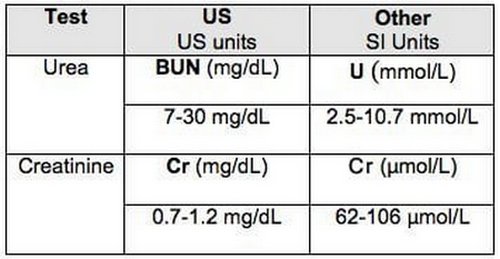BUN/Creatinine Ratio Understand (High vs. Low Levels, Normal Range)
Last reviewed by Editorial Team on February 27th, 2019.
A BUN creatinine ratio is a blood work done to detect acute or chronic renal disease/failure.
Both BUN and creatinine are filtered in the kidneys and excreted through urination and they are a perfect parameter for identifying the overall functions of the kidneys. (1, 2)

Image 1: The standard unit of measurements for BUN and creatinine.
Picture Source: lifeinthefastlane.com
Understanding the difference between BUN and creatinine test and their relationship
BUN Test
BUN stands for Blood Urea Nitrogen. The BUN test measures the level of nitrogen in the blood.
Doctors order this test to assess the functions of the kidneys and liver.
Nitrogen is urea’s waste product. The function of the kidneys is to filter the urea so that waste products will be removed from the body through urination.
The liver continuously produces urea and so it is just normal to have a small amount of urea in the blood. If the urea in the blood is abnormally high, it is an indicator that the kidneys are not functioning well.
There could be something wrong with your kidneys that need to be addressed properly and timely. (1, 2, 3)
Creatinine Test
A creatinine is a molecule produced by muscle metabolism. It is transported through the bloodstream and filtered in the kidneys and excreted through the urine.
The muscle mass of a person defines the rate of creatinine formation. Ideally, the level of creatinine remains constant throughout the day.
If the level of creatinine is high, then it indicates that there is something wrong with your kidneys. (3, 4)

Picture 2: BUN and creatinine ratio is measured using the above formula.
Photo Source: www.labpedia.net
What is a BUN creatinine ratio and its significance?
The BUN and creatinine test results are combined by the doctor to determine the BUN to creatinine ratio.
This is to find out the functions and overall condition of the liver and kidneys. It is used by the doctor in formulating an accurate diagnosis of health problems that have something to do with the kidneys.
Other reasons for taking BUN to creatinine ratio test include the following:
- Evaluate the functions of the kidneys
- Diagnose kidney-related diseases such as acute and/or chronic renal disease and urinary tract blockages
- Monitor the effectiveness of the treatments related to kidney problems
- It helps in diagnosing gastrointestinal bleeding
- It is useful in diagnosing severe dehydration (causes the BUN level to rise) (2, 3, 4, 5)
What can cause a high bun creatinine ratio?
- Congestive heart failure
- Urinary tract obstruction
- Gastrointestinal bleeding
- Trauma (5, 6)
What can cause a low BUN creatinine ratio?
- Liver-related diseases
- Low protein diet
- Severe polyuria and polydipsia
- Diabetes mellitus
- Cushing’s disease (6, 7)
What can cause an increase creatinine with normal BUN level?
- Severe muscle trauma
- Acute myositis
- Too much intake of ascorbic acid (vitamin C)
- Intake of cephalosporins (7)
What can cause a high BUN and normal creatinine?
- Gastrointestinal hemorrhage
- High protein diet
- Fever
- Intake of corticosteroids or tetracyclines (8, 9)
What can cause a low creatinine and normal BUN?
- Decrease muscle mass
- Severe cachexia (9, 10)
What to keep in mind before undergoing a BUN creatinine ratio test?
Your protein intake can significantly affect the test result. A high protein intake may cause an abnormally high level of BUN. On the other hand, a low protein intake may lead to an abnormally low level of BUN.
If you are going to undertake a BUN creatinine ratio test, make sure that you consume a normal amount of protein and that you are properly hydrated.
That way, you will be able to come up with an accurate BUN creatinine ratio test result. The result can also be affected by pregnancy. (2, 5, 8, 9)
“Click on image for the calculator”
Photo 3: A blood sample is drawn from the patient’s arm and sent immediately to the lab for testing and evaluation.
Image Source: lh3.googleusercontent.com

Image 4: BUN and creatinine are two parameters used to detect the condition of the kidneys.
Picture Source: i.ytimg.com
How is the test taken?
The procedure is performed by a lab technician. A blood is drawn from your upper arm using a sterile needle. The entire process would take around 5 to 10 minutes depending on the visibility of your vein.
What is a normal BUN and creatinine level ratio?
To get the BUN creatinine ratio, the BUN count is divided by the creatinine count.
What is the normal BUN creatinine ratio?
The ideal ratio is between 10:1 and 20:1. If the result is higher than the numbers mentioned, it indicates that there is a high level of BUN in the blood.
It is linked with kidney-related diseases or decreased flow of blood to the kidneys secondary to dehydration or congestive heart failure. If the result is below the normal ratio, then it could indicate malnutrition or liver-related diseases. (3, 6, 9, 10)
Final Word
The BUN and creatinine are both end products of metabolism. The BUN and creatinine are waste products that need to be filtered by the kidneys and excreted through urination.
A small amount of BUN and creatinine may be present in the blood and are just normal. However, if the ratios are too high or too low, it could signal that there is something wrong in your kidneys and liver.
A high BUN and creatinine ratio could indicate a possible kidney-related problem.
References:
- https://en.wikipedia.org/wiki/BUN-to-creatinine_ratio
- https://www.questdiagnostics.com/testcenter/TestDetail.action?ntc=296
- https://www.sciencedirect.com/topics/medicine-and-dentistry/bun-to-creatinine-ratio
- https://www.healthlabs.com/bun-creatinine-ratio-testing
- https://acutecaretesting.org/en/articles/urea-and-creatinine-concentration-the-urea-creatinine-ratio
- https://lifeinthefastlane.com/ccc/ureacreatinine-ratio/
- https://www.ahajournals.org/doi/abs/10.1161/circheartfailure.112.968230
- https://www.mayoclinic.org/tests-procedures/blood-urea-nitrogen/about/pac-20384821
- https://www.selfhacked.com/blog/bun-creatinine-ratio-high-low-levels-normal-range/
- https://www.beaumontlaboratory.com/test-lab-directory/lab-test-details/?testid=1305
Similar Posts:
- Estimated Glomerular Filtration Rate ( eGFR) Test & Calculators
- Types of Blood Cells
- Urease Test
- Benedict’s Test
- Catalase Test

